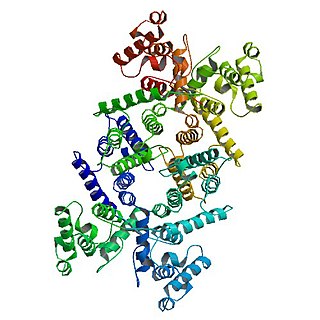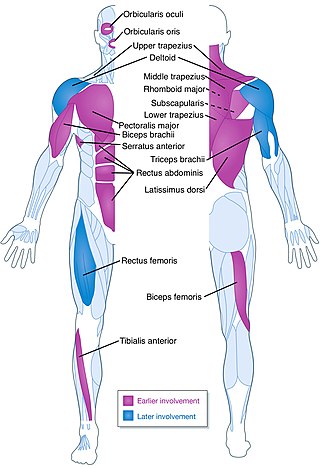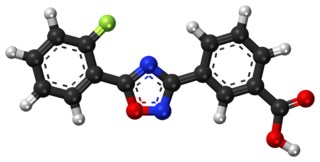Related Research Articles

Muscular dystrophies (MD) are a genetically and clinically heterogeneous group of rare neuromuscular diseases that cause progressive weakness and breakdown of skeletal muscles over time. The disorders differ as to which muscles are primarily affected,the degree of weakness,how fast they worsen,and when symptoms begin. Some types are also associated with problems in other organs.

A glycogen storage disease is a metabolic disorder caused by a deficiency of an enzyme or transport protein affecting glycogen synthesis,glycogen breakdown,or glucose breakdown,typically in muscles and/or liver cells.

Limb–girdle muscular dystrophy (LGMD) is a genetically heterogeneous group of rare muscular dystrophies that share a set of clinical characteristics. It is characterised by progressive muscle wasting which affects predominantly hip and shoulder muscles. LGMD usually has an autosomal pattern of inheritance. It currently has no known cure or treatment.

Dystrophin is a rod-shaped cytoplasmic protein,and a vital part of a protein complex that connects the cytoskeleton of a muscle fiber to the surrounding extracellular matrix through the cell membrane. This complex is variously known as the costamere or the dystrophin-associated protein complex (DAPC). Many muscle proteins,such as α-dystrobrevin,syncoilin,synemin,sarcoglycan,dystroglycan,and sarcospan,colocalize with dystrophin at the costamere. It has a molecular weight of 427 kDa

Duchenne muscular dystrophy (DMD) is a severe type of muscular dystrophy predominantly affecting boys. The onset of muscle weakness typically begins around age four,with rapid progression. Initially,muscle loss occurs in the thighs and pelvis,extending to the arms,which can lead to difficulties in standing up. By the age of 12,most individuals with Duchenne muscular dystrophy are unable to walk. Affected muscles may appear larger due to an increase in fat content,and scoliosis is common. Some individuals may experience intellectual disability,and females carrying a single copy of the mutated gene may show mild symptoms.

Becker muscular dystrophy (BMD) is an X-linked recessive inherited disorder characterized by slowly progressing muscle weakness of the legs and pelvis. It is a type of dystrophinopathy. The cause is mutations and deletions in any of the 79 exons encoding the large dystrophin protein,essential for maintaining the muscle fiber's cell membrane integrity. Becker muscular dystrophy is related to Duchenne muscular dystrophy in that both result from a mutation in the dystrophin gene,however the hallmark of Becker is milder in-frame deletions. and hence has a milder course,with patients maintaining ambulation till 50–60 years if detected early.
In medicine,myopathy is a disease of the muscle in which the muscle fibers do not function properly. Myopathy means muscle disease. This meaning implies that the primary defect is within the muscle,as opposed to the nerves or elsewhere.

Facioscapulohumeral muscular dystrophy (FSHD) is a type of muscular dystrophy,a group of heritable diseases that cause degeneration of muscle and progressive weakness. Per the name,FSHD tends to sequentially weaken the muscles of the face,those that position the scapula,and those overlying the humerus bone of the upper arm. These areas can be spared,and muscles of other areas usually are affected,especially those of the chest,abdomen,spine,and shin. Almost any skeletal muscle can be affected in advanced disease. Abnormally positioned,termed 'winged',scapulas are common,as is the inability to lift the foot,known as foot drop. The two sides of the body are often affected unequally. Weakness typically manifests at ages 15 –30 years. FSHD can also cause hearing loss and blood vessel abnormalities at the back of the eye.

Myositis is a rarely-encountered medical condition characterized by inflammation affecting the muscles. The manifestations of this condition may include skin issues,muscle weakness,and the potential involvement of other organs. Additionally,systemic symptoms like weight loss,fatigue,and low-grade fever can manifest in individuals with myositis.

A neuromuscular disease is any disease affecting the peripheral nervous system (PNS),the neuromuscular junctions,or skeletal muscles,all of which are components of the motor unit. Damage to any of these structures can cause muscle atrophy and weakness. Issues with sensation can also occur.

Deflazacort is a glucocorticoid belonging to acetonides or O-isopropylidene derivative. It is used as an anti-inflammatory and was patented in 1969 and approved for medical use in 1985. The U.S. Food and Drug Administration (FDA) considers it to be a first-in-class medication for Duchenne Muscular Dystrophy.

Sarcospan is a protein that in humans is encoded by the SSPN gene.

Ataluren,sold under the brand name Translarna,is a medication for the treatment of Duchenne muscular dystrophy. It was designed by PTC Therapeutics.
TREAT-NMD is a global academic network that focuses on advancing research in neuromuscular disorders. It was established in 2007 with its coordination centre at the Newcastle University. As of 2018,the network comprises over a hundred research centres and patient organisations from 54 countries as well as independent academics and patient representatives. The network's aim is to provide infrastructure to accelerating research through supporting collaboration between its members. Its main goals include improving trial-readiness worldwide,advancing patient diagnosis and care and accelerating pre-clinical research.
Givinostat,sold under the brand name Duvyzat is a medication used for the treatment of Duchenne muscular dystrophy. It is a histone deacetylase inhibitor with potential anti-inflammatory,anti-angiogenic,and antineoplastic activities. It is a histone deacetylase (HDAC) inhibitor that works by targeting pathogenic processes to reduce inflammation and loss of muscle.

Vamorolone,sold under the brand name Agamree,is a synthetic corticosteroid,which is used for the treatment of Duchenne muscular dystrophy. It is taken by mouth. It is a dual atypical glucocorticoid and antimineralocorticoid.

David Gardner-Medwin was a British physician who worked as a paediatric neurologist in Newcastle upon Tyne,serving as the only neurologist for children for a population of 3.5 million. He is credited with introducing multidisciplinary care to the management of boys with Duchenne muscular dystrophy (DMD). When he retired at the age of 60,four consultants were appointed to replace him.
Toshifumi (Toshi) Yokota is a medical scientist and professor of medical genetics at the University of Alberta,where he also holds the titles of the Friends of Garrett Cumming Research &Muscular Dystrophy Canada Endowed Research Chair and the Henri M. Toupin Chair in Neurological Science. He is best known for his pioneering research in antisense therapy for muscular dystrophy that led to the development of an FDA-approved drug viltolarsen. His research interests include precision medicine for muscular dystrophy and genetic diseases. He has co-edited three books published in the Methods in Molecular Biology series from Humana Press,Springer-Nature,and has published more than 100 refereed papers and patents. He is a fellow of the Canadian Academy of Health Sciences,a member of the editorial boards for the International Journal of Molecular Sciences,Genes,Frontiers in Genome Editing,Frontiers in Physiology,and Nucleic Acid Therapeutics,a member of the Medical and Scientific Advisory Committee of Muscular Dystrophy Canada,and a co-founder of the Canadian Neuromuscular Network (CAN-NMD).

Pseudohypertrophy,or false enlargement, is an increase in the size of an organ due to infiltration of a tissue not normally found in that organ. It is commonly applied to enlargement of a muscle due to infiltration of fat or connective tissue,famously in Duchenne muscular dystrophy. This is in contrast with typical muscle hypertrophy,in which the muscle tissue itself increases in size. Because pseudohypertrophy is not a result of increased muscle tissue,the muscles look bigger but are actually atrophied and thus weaker. Pseudohypertrophy is typically the result of a disease,which can be a disease of muscle or a disease of the nerve supplying the muscle.
References
- ↑ Nagaraju, K.; Raben, N.; Loeffler, L.; Parker, T.; Rochon, P. J.; Lee, E.; Danning, C.; Wada, R.; Thompson, C. (1 August 2000). "Conditional up-regulation of MHC class I in skeletal muscle leads to self-sustaining autoimmune myositis and myositis-specific autoantibodies". Proceedings of the National Academy of Sciences of the United States of America. 97 (16): 9209–9214. doi: 10.1073/pnas.97.16.9209 . ISSN 0027-8424. PMC 16847 . PMID 10922072.
- ↑ Willmann, Raffaella; De Luca, Annamaria; Benatar, Michael; Grounds, Miranda; Dubach, Judith; Raymackers, Jean-Marc; Nagaraju, Kanneboyina; TREAT-NMD Neuromuscular Network (January 2012). "Enhancing translation: guidelines for standard pre-clinical experiments in mdx mice". Neuromuscular Disorders. 22 (1): 43–49. doi:10.1016/j.nmd.2011.04.012. ISSN 1873-2364. PMC 3227750 . PMID 21737275.
- ↑ Willmann, Raffaella; Luca, Annamaria De; Nagaraju, Kanneboyina; Rüegg, Markus A. (14 May 2015). "Best Practices and Standard Protocols as a Tool to Enhance Translation for Neuromuscular Disorders" (PDF). Journal of Neuromuscular Diseases. 2 (2): 113–117. doi:10.3233/jnd-140067. ISSN 2214-3599. PMID 27858730.
- ↑ Gordish-Dressman, Heather; Willmann, Raffaella; Dalle Pazze, Laura; Kreibich, Arati; van Putten, Maaike; Heydemann, Ahlke; Bogdanik, Laurent; Lutz, Cathleen; Davies, Kay (2018). ""Of Mice and Measures": A Project to Improve How We Advance Duchenne Muscular Dystrophy Therapies to the Clinic". Journal of Neuromuscular Diseases. 5 (4): 407–417. doi:10.3233/JND-180324. ISSN 2214-3599. PMC 6218134 . PMID 30198876.